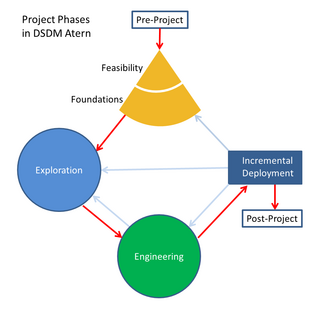
In engineering and its various subdisciplines, acceptance testing is a test conducted to determine if the requirements of a specification or contract are met. It may involve chemical tests, physical tests, or performance tests.

Iterative and incremental development is any combination of both iterative design or iterative method and incremental build model for development.
A software company is an organisation — owned either by the state or private — established for profit whose primary products are various forms of software, software technology, distribution, and software product development. They make up the software industry.
The rational unified process (RUP) is an iterative software development process framework created by the Rational Software Corporation, a division of IBM since 2003. RUP is not a single concrete prescriptive process, but rather an adaptable process framework, intended to be tailored by the development organizations and software project teams that will select the elements of the process that are appropriate for their needs. RUP is a specific implementation of the Unified Process.
Rapid application development (RAD), also called rapid application building (RAB), is both a general term for adaptive software development approaches, and the name for James Martin's method of rapid development. In general, RAD approaches to software development put less emphasis on planning and more emphasis on an adaptive process. Prototypes are often used in addition to or sometimes even instead of design specifications.

PRINCE2 is a structured project management method and practitioner certification programme. PRINCE2 emphasises dividing projects into manageable and controllable stages.

In systems engineering, information systems and software engineering, the systems development life cycle (SDLC), also referred to as the application development life cycle, is a process for planning, creating, testing, and deploying an information system. The SDLC concept applies to a range of hardware and software configurations, as a system can be composed of hardware only, software only, or a combination of both. There are usually six stages in this cycle: requirement analysis, design, development and testing, implementation, documentation, and evaluation.
Web development is the work involved in developing a website for the Internet or an intranet. Web development can range from developing a simple single static page of plain text to complex web applications, electronic businesses, and social network services. A more comprehensive list of tasks to which Web development commonly refers, may include Web engineering, Web design, Web content development, client liaison, client-side/server-side scripting, Web server and network security configuration, and e-commerce development.
Agile software development is the mindset for developing software that derives from values agreed upon by The Agile Alliance, a group of 17 software practitioners in 2001. As documented in their Manifesto for Agile Software Development the practitioners value:
Software prototyping is the activity of creating prototypes of software applications, i.e., incomplete versions of the software program being developed. It is an activity that can occur in software development and is comparable to prototyping as known from other fields, such as mechanical engineering or manufacturing.
A product software implementation method is a systematically structured approach to effectively integrate a software based service or component into the workflow of an organizational structure or an individual end-user.
In agile principles, timeboxing allocates a maximum unit of time to an activity, called a timebox, within which a planned activity takes place. It is used by agile principles-based project management approaches and for personal time management.
Microsoft Solutions Framework (MSF) is a set of principles, models, disciplines, concepts, and guidelines for delivering information technology services from Microsoft. MSF is not limited to developing applications only; it is also applicable to other IT projects like deployment, networking or infrastructure projects. MSF does not force the developer to use a specific methodology.
Adaptive software development (ASD) is a software development process that grew out of the work by Jim Highsmith and Sam Bayer on rapid application development (RAD). It embodies the principle that continuous adaptation of the process to the work at hand is the normal state of affairs.
The incremental build model is a method of software development where the product is designed, implemented, and tested incrementally until the product is finished. It involves both development and maintenance. The product is defined as finished when it satisfies all of its requirements. This model combines the elements of the waterfall model with the iterative philosophy of prototyping. According to the Project Management Institute, an incremental approach is an "adaptive development approach in which the deliverable is produced successively, adding functionality until the deliverable contains the necessary and sufficient capability to be considered complete."
Internet-Speed development is an Agile Software Development development method using a combined spiral model/waterfall model with daily builds aimed at developing a product with high speed.

The unified software development process or unified process is an iterative and incremental software development process framework. The best-known and extensively documented refinement of the unified process is the rational unified process (RUP). Other examples are OpenUP and agile unified process.
A glossary of terms relating to project management and consulting.
In software engineering, a software development process or software development life cycle (SDLC) is a process of planning and managing software development. It typically involves dividing software development work into smaller, parallel, or sequential steps or sub-processes to improve design and/or product management. The methodology may include the pre-definition of specific deliverables and artifacts that are created and completed by a project team to develop or maintain an application.
Small-scale project management is the specific type of project management of small-scale projects. These projects are characterised by factors such as short duration; low person hours; small team; size of the budget and the balance between the time committed to delivering the project itself and the time committed to managing the project. They are otherwise unique, time delineated and require the delivery of a final output in the same way as large-scale projects.





